In the rapidly evolving landscape of digital dentistry, 3Shape stands as one of the pioneering forces. The Danish company has maintained its position as a premium brand in the intraoral scanner (IOS) market since 2015-2016 when they revolutionized digital impression-taking with the TRIOS 3.
Late 2022 marked a significant milestone for 3Shape with the release of their flagship scanner – the TRIOS 5. This release came at a crucial time in the scanner market's evolution, with increased competition from both established manufacturers and newer budget-friendly entrants challenging 3Shape's premium positioning.
As a full-time clinician and founder of the Institute of Digital Dentistry, I've had the unique opportunity to extensively test virtually every intraoral scanner available. My journey with 3Shape products spans over six years, starting with the TRIOS 3, progressing to the TRIOS 4, and now culminating with the TRIOS 5, which I've been using daily in our nine-chair practice for years.
This experience has given me a comprehensive understanding of not just the TRIOS 5's capabilities, but its position within the broader evolution of 3Shape's product lineup and the intraoral scanner market as a whole.
In 2024's scanner landscape, the traditional differentiators like scanning speed have become less relevant as most premium scanners now offer comparable performance in this area. This market maturation has pushed manufacturers to differentiate through software ecosystems, ergonomics, and specialized clinical capabilities – areas where we'll focus our evaluation of the TRIOS 5.
As always, this review remains completely independent. While I maintain professional relationships with many companies in the digital dentistry space, this review was written without any input or financial compensation from 3Shape. The Institute of Digital Dentistry does not sell 3Shape products, and our commitment to objectivity remains a core principle of our evaluation process.
Review At a Glance
The 3Shape TRIOS 5 is a solid choice for anyone who wants a 'do-it-all' intraoral scanner. It is one of the best scanners money can buy, but it does come with a premium price tag.
Pros:
Cons:
Compare The IOS Market - In One Document
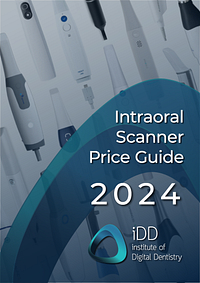
Cost is the number one barrier for all clinicians who want to start getting into digital dentistry and intraoral scanning. That is a proven fact.
To help you navigate all the numbers, we have outlined the prices of some of the latest scanners available.
TRIOS 5 Scan Speed
While scanning speed has become less of a differentiating factor among top-tier intraoral scanners in 2025's digital dentistry market, the TRIOS 5 still impresses with its swift and reliable scanning capabilities. This scanner represents the pinnacle of 3Shape's scanning technology evolution.
In daily clinical use, I routinely complete full arch scans within 35 seconds, with my fastest scans taking as little as 18 seconds. This represents a modest improvement over previous TRIOS models, which were already known for their efficient scanning times. The speed is complemented by exceptional accuracy, with the scanner producing consistently reliable results across various clinical scenarios.
What truly sets the TRIOS 5 apart is its handling of traditionally challenging scanning situations. In particular, edentulous scanning. Capturing accurate scans of edentulous areas has historically been a challenge for intraoral scanners, but the TRIOS 5 handles these cases remarkably well. The scanner's ability to maintain tracking on non-distinct tissue surfaces, combined with 3Shape's sophisticated stitching algorithms, makes it one of the best scanners on the market for edentulous cases.
TRIOS 5 is an excellent scanner.
TRIOS 5’s ScanAssist Feature
A standout technological advancement in the TRIOS 5 is the introduction of ScanAssist. This AI-driven feature represents a significant improvement over previous TRIOS generations, utilizing algorithms to minimize stitching errors and improve scan quality.
While difficult to quantify precisely, side-by-side testing with earlier TRIOS models reveals noticeable improvements in scan continuity and error reduction. The practical benefit for clinicians is evident as the software does a superior job of correctly piecing together scan segments, reducing the frequency of stitching errors in my experience.
This technology is particularly valuable in challenging scanning scenarios. The TRIOS 5 maintains tracking more reliably and recovers more predictably when tracking is temporarily lost.
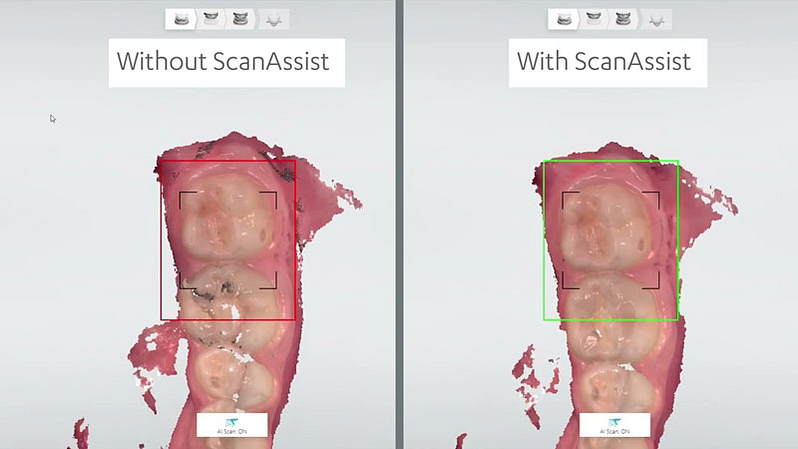
Clinical Versatility
After a year of intensive use by all our clinicians in our multi-chair practice, we have used the TRIOS 5 for virtually every conceivable dental indication: single crowns, multiple-unit bridges, implant restorations, All-on-X cases, orthodontic records, and complete dentures, spanning patients of all ages and clinical presentations.
Not once did I encounter a situation where the scanner couldn't capture the necessary data. This clinical versatility has has been one of the best features of the TRIOS 5 and to be honest all TRIOS scanners.
One interesting design change from previous TRIOS models is the closed-tip scanner head. For clinicians accustomed to the open-tip design of the TRIOS 3 and 4, this represents a learning curve. The open design allowed positioning teeth partially inside the scanner tip when navigating difficult-to-reach areas like distal surfaces of second molars. This technique is no longer possible with the TRIOS 5, potentially making some areas slightly more challenging to capture. However, with adjusted technique, all areas remain scannable.
TRIOS 5 Design and Ergonomics
The TRIOS 5 features a sleek two-tone black and white design with 3Shape's signature red accents. Build quality is excellent with materials that have proven durable through a year of clinical use and countless disinfection cycles. The scanner feels substantial without being unnecessarily heavy.
The wireless implementation at 299 grams achieves a good balance between functionality and user comfort. Despite housing a battery, the scanner feels well-balanced, avoiding the back-heaviness common in many wireless devices. This weight distribution helps reduce hand fatigue during extended scanning sessions.
The scanner's durability seems good—I've accidentally dropped it once or twice with no immediate damage, though I wouldn't recommend testing this deliberately. The packaging is high quality, reminiscent of premium consumer electronics.
Battery System and Wireless Operation
The TRIOS 5's battery system represents a significant improvement over the TRIOS 4, which often required connection to a power cable due to inadequate battery life. The new system includes three interchangeable batteries that slide easily into the back of the device, allowing quick swaps if needed.
Battery life is much better. I rarely need to change batteries more than once per day even with frequent scanning. The batteries feature a clever indicator system: tapping twice shows remaining charge via LED lights without needing to insert them into the scanner.
A separate docking station charges two batteries simultaneously, ensuring replacements are always ready. Combined with the scanner's sleep mode for preserving battery when idle, the overall power management system works well in daily practice.
3Shape has committed fully to wireless scanning with the TRIOS 5—there's no option to convert it to a wired scanner with a dummy battery. While this might concern some users, the wireless implementation is reliable enough that this hasn't been problematic in daily use.
Battery System
The battery system represents a major improvement over the previous TRIOS 4, which suffered from inadequate battery life that often forced users to operate tethered to power. The TRIOS 5 introduces a completely redesigned battery solution that addresses these limitations comprehensively.
The scanner comes with three interchangeable batteries that slide easily into the rear of the device. Battery swaps can be performed in seconds, ensuring continuous operation even during battery depletion. In practical terms, battery life is excellent – a single charge typically lasts through multiple patient appointments, and I rarely need to swap batteries more than once during a full clinical day.
A particularly thoughtful feature is the battery status indication system – tapping a battery twice activates LED indicators showing the remaining charge without needing to insert it into the scanner. This simple innovation eliminates the guesswork from battery management.
The included charging dock accommodates two batteries simultaneously, ensuring replacement batteries are always ready. Combined with the scanner's sleep mode, which preserves battery life during inactivity, the overall power management system feels thoroughly considered and clinically practical.

3Shape TRIOS 5 Batteries x3.

3Shape TRIOS 5 Battery Level LED Light Indicator.
Scanner Tips
The TRIOS 5 introduces a closed scanner tip design focused on improved hygiene by preventing fluid ingress into the scanner's internal components. These tips click firmly into place in only one direction and feel secure during use.
Although they can make scanning tight-to-reach areas a little trickier, the closed-off design allows you to rest the scanner on the teeth and glide it across the surface during very fast scanning, which was not possible with the open design of previous models because nothing ever ‘hits’ or gets stuck in the scanning tip.
Each tip is autoclavable up to 100 times, though they sometimes collect stains and discolor, particularly if exposed to lipstick that isn't thoroughly cleaned before autoclaving. The tips appear more durable than previous TRIOS generations, with no instances of the edge breakage that plagued earlier models.
The plastic quality of the tips feels somewhat inconsistent with the premium build of the scanner itself, but this is understandable given their semi-disposable nature.
Compare The IOS Market - In One Document

Cost is the number one barrier for all clinicians who want to start getting into digital dentistry and intraoral scanning. That is a proven fact.
To help you navigate all the numbers, we have outlined the prices of some of the latest scanners available.
TRIOS 5’s Connectivity and Reliability
For this review, I used the laptop version of the TRIOS 5, which comes with a Dell laptop and TP-Link dongle for wireless connectivity. This is perhaps the weakest aspect of the entire package.
The TP-Link dongle looks incongruously generic alongside the otherwise premium hardware and, more importantly, occasionally presents connectivity issues. While connection is extremely reliable once established—I never experienced disconnections during scanning—initially pairing the scanner with the computer can sometimes be problematic.
This occurred particularly when switching between different scanners on the same computer. I eventually developed a troubleshooting routine: removing the scanner battery, turning off the scanner, unplugging the dongle, then reassembling everything. This usually resolves the issue within a minute, but it's an annoyance that feels unnecessary in a premium product.
The Dell laptop included with the system is arguably its greatest weakness. It's bulky with an average display and—more critically—suffers from noticeable performance issues when running the TRIOS software. The system occasionally lags, especially during extended use, and generates excessive heat even when idle. These limitations became particularly apparent during an intensive scanning session with professional athletes, where I eventually had to switch to another scanner system due to performance degradation.
For practices considering the TRIOS 5, the MOVE Cart option might be worth the additional investment. I've used this with the TRIOS 4 and found it excellent in terms of design, ergonomics, and patient engagement. Its only significant drawback is the lack of battery power, requiring connection to an outlet when moving between operatories.
3Shape also offers TRIOS Share as an alternative connectivity option, which eliminates the Wi-Fi dongle and allows scanner sharing across multiple operatories through the clinic's network infrastructure.
TRIOS 5’s Software and Ecosystem
As scanner hardware capabilities have converged across manufacturers, software has become an increasingly important differentiator. This is where 3Shape's experience shows, with a comprehensive ecosystem developed over nearly a decade.
3Shape Unite Software
Within the past year, 3Shape released Unite, a significant update to their scanner software interface. The new interface makes logical workflow improvements, creating a more intuitive user experience. Patient information entry and lab form completion are straightforward, and the addition of a "status scan" button allows immediate scanning without completing the lab form first.
The system includes workflows for virtually every dental indication, from basic restorative procedures to complex implant cases. Patient cases are organized in comprehensive digital files that include all data sets, imported photos, and related information.
One limitation is the inability to add custom scanning windows freely, which would provide additional flexibility for certain workflows. Otherwise, the software is comprehensive and user-friendly.
Integrated Applications
The 3Shape ecosystem includes numerous integrated applications that expand the scanner's clinical utility:
AI Model Builder/Model Builder Express provides automated model creation for 3D printing directly from scan data. Available in fully automated AI and customizable versions, it efficiently generates printable models with minimal user input. While not offering quite the same level of customization as Medit's Model Builder (still the market standard), it provides excellent functionality and ranks as a close second.
Orthodontic Simulator visualizes potential orthodontic treatment outcomes with realistic tooth coloration and the ability to simulate interproximal reduction (IPR). It's not quite as sophisticated as iTero's ortho simulator (the current benchmark) but provides good functionality at no additional cost.
Smile Design is arguably 3Shape's standout application, creating realistic smile simulations with minimal effort. Its intuitive interface and high-quality tooth libraries produce excellent results for patient communication and treatment planning.
These applications are available without additional cost through the 3Shape Unite store but exclusively for 3Shape scanner owners, unlike Medit's approach of offering most applications to any scanner user.
Future-Focused Developments
3Shape is investing heavily in AI-driven solutions that may significantly impact digital workflow efficiency. 3Shape Automate, their AI-powered CAD design platform, has already processed over 2 million designs with a 94% acceptance rate. Currently, it can design single unit crowns, night guards, and copings.

Anterior Crowns.
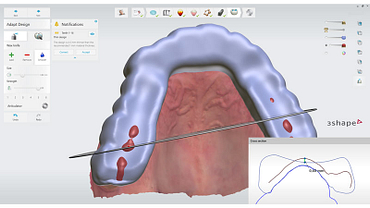
Splint/Nightguards.
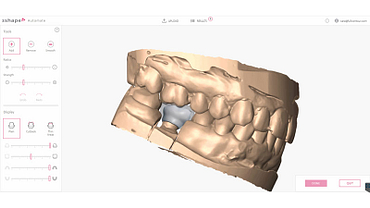
Copings.
In testing, I found posterior crown designs generally excellent, especially with good preparations. Anterior designs and night guards sometimes require adjustments, but the technology shows promise for streamlining many routine design tasks.
3Shape Produce represents another significant development, aiming to simplify in-house manufacturing by integrating with various milling machines and 3D printers. This platform addresses the often cumbersome workflow of exporting designs to production equipment, though it's still in early stages with limited device support.
Its intuitive interface and, more importantly, high-quality tooth libraries make it probably the stand-out 3Shape app in the entire library. I would highly recommend everyone learn how to use this if they want to do more cosmetic cases.
These apps, and many others, are available for free on the 3Shape Unite store, exclusively for 3Shape customers. Unlike Medit apps, which are free to use by anyone with an IOS, you can only use these if you have a TRIOS.
, an AI-powered CAD design platform, has already shown impressive results, with over 2 million designs completed at a 94% acceptance rate.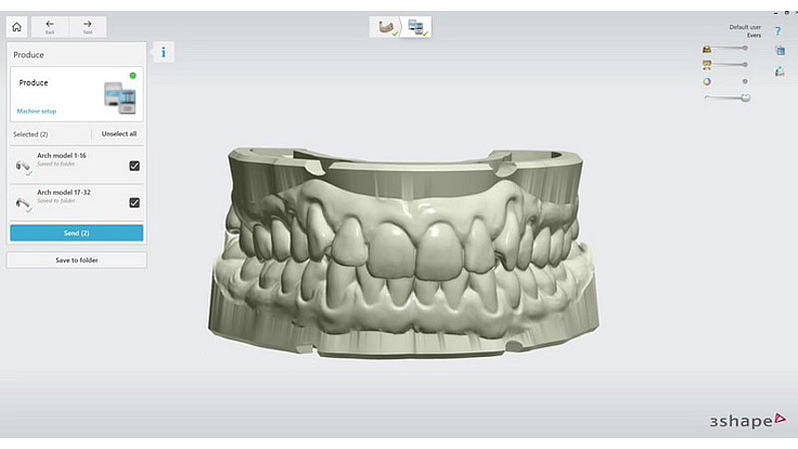
Export Options and Compatibility
The TRIOS 5 offers standard export capabilities, providing files in two formats:
- Monochrome STL
- Color PLY
OBJ export is not available.
The TRIOS 5 cannot be used with Invisalign, maintaining Align Technology's strategic limitation on TRIOS compatibility.
How Much Does the TRIOS 5 Cost?
At $25,900 USD for the scanner alone, the TRIOS 5 positions itself firmly in the premium scanner segment. While expensive, this actually represents 3Shape's most competitive pricing for a flagship scanner at launch, reflecting increasing market competition.
For practices considering the MOVE Cart configuration, there's an additional $7,000 USD investment. The laptop version typically adds around $2,000 USD to the package price.
Additional costs include scanner tips (approximately $300 USD for a pack of three) and potentially the TRIOS Care subscription at $2,300 USD annually. While the scanner functions without subscription under the "TRIOS Only" option, TRIOS Care provides support, extended warranty, and replacement coverage.

Everything you get when you purchase the TRIOS 5.
This price point is particularly noteworthy, representing a shift in 3Shape's pricing strategy. It is the lowest launch price for a flagship TRIOS scanner to date, reflecting the company's recognition of the increasingly competitive intraoral scanner market.
In conjunction with the TRIOS 5 launch, 3Shape has also adjusted the pricing for its previous generation scanners.
The TRIOS 3 now has a recommended retail price of around $18,000 USD, while the TRIOS 4 is priced at approximately $22,000 USD. These price adjustments provide dental professionals with a range of options to suit their budgets and specific needs.
It is important to note that the pricing mentioned above is for the scanner alone. If you prefer the TRIOS Move cart configuration, which is one of the best scanner carts in terms of ergonomics on the market, there is an additional cost of $7,000 USD.
Alternatively, the TRIOS 5 is available in a laptop version, including a pre-configured laptop for use with the scanner. This is typically 2k USD on top of the scanner price sold by the distributor.
Other costs to consider:
Scanner Tips
These come in a box of 3 for approximately $300 USD
This means that each scanner tip costs around $100 USD and can be autoclaved up to 100 times which means it will cost around 1 dollar per patient scan.
TRIOS Care Subscription
The TRIOS scanners are now subscription-free scanners.
Meaning if you want, you can opt for ‘TRIOS Only,’ which is totally free of any yearly fees, the company does have a service package, ‘TRIOS Care,’ which is a fee of 2300 USD per year and includes support and replacement options if damage occurs.
Conclusion
After extensive clinical use across diverse scenarios, the TRIOS 5 demonstrates both significant strengths and some notable limitations.
The scanner delivers excellent technical performance, particularly in challenging scenarios like edentulous scanning. The wireless implementation with its well-designed battery system works reliably in daily practice. The software ecosystem provides comprehensive functionality that continues to expand with AI-driven innovations. Build quality and materials reflect the scanner's premium positioning.
However, several limitations are worth considering. The included laptop underperforms relative to the scanner's capabilities and the overall package price. Occasional connectivity issues, while manageable, detract from the otherwise seamless experience. The premium pricing positions the scanner beyond the reach of many practices, particularly those just beginning their digital dentistry journey.
Is the TRIOS 5 "the best scanner money can buy" as suggested in the title? This depends on specific practice priorities and requirements. For practices prioritizing comprehensive software integration and performance in challenging scanning scenarios, the TRIOS 5 makes a strong case. However, practices with budget constraints, those requiring absolute ergonomic refinement, or those needing Invisalign integration might find alternative options more suitable.
The scanner market has evolved to where "best" increasingly depends on specific practice needs rather than universal technical superiority. What's clear is that the TRIOS 5 represents one of the most capable scanning systems available, with strengths that justify its premium positioning for practices with the budget to accommodate it.
For those considering this investment, the TRIOS 5 delivers excellent clinical performance, but careful consideration of the complete package—including computer hardware and ongoing costs—remains essential to maximize return on this substantial investment.
Evaluation Ratings
Scanning Speed
Scanning Flow
Scanner Size
Ease of Use
Scanner Software
Investment Cost
Additional Features
USB scanner
TP-Link Dongle for wireless
Wireless Scanner
Caries Detection
Software Apps
Extensive range including smile design and ortho simulation
CAD/CAM Software
Fully fledged 3Shape CAD software purchased seperately
Subscription Requirements
TRIOS Only = Subscription Free
TRIOS Care subscription exists.
Autoclavable Tips
100 times per tip

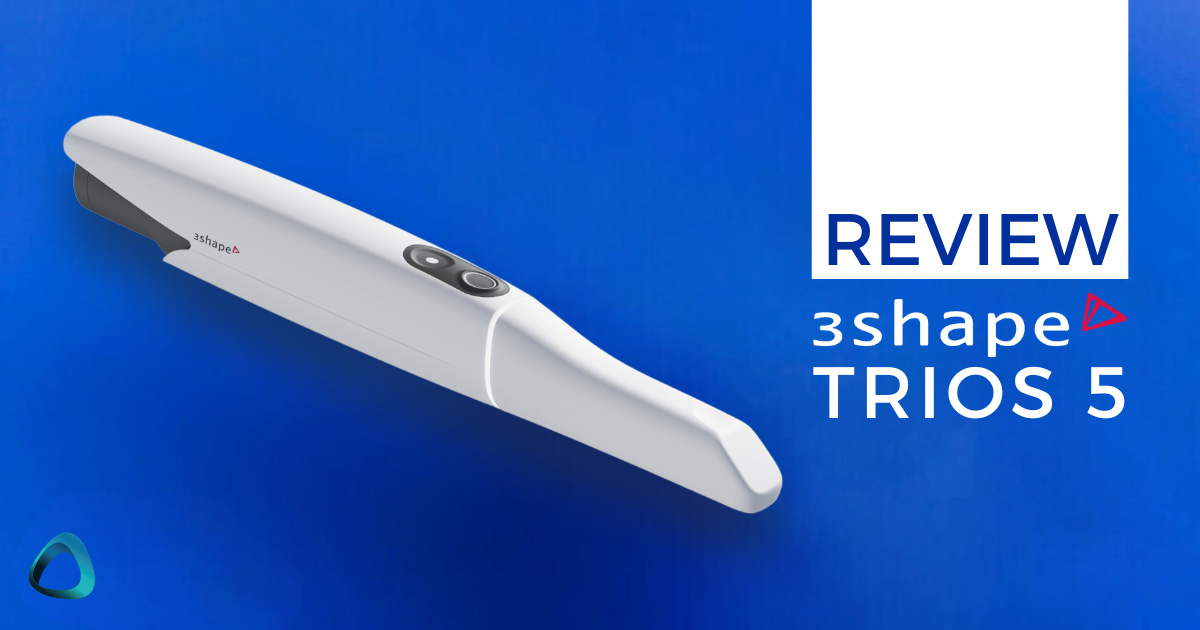
Too bad this review doesn’t really evaluate the accuracy of the unit like you did in the past.
We moved that all to an entire section – https://instituteofdigitaldentistry.com/category/idd-compares/
Chceck out all our comparisons in accuracy there!